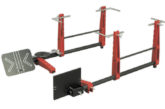
Point-S UK explains the benefits of all-season tyres, a useful upsell for independent garages at any time of year.
The fundamental challenge with all-season tyres has always been the compromise between summer and winter performance characteristics. Traditional rubber compounds that remain flexible in sub-zero temperatures tend to become too soft in summer heat, increasing rolling resistance and reducing precision. Conversely, compounds optimised for summer performance typically become rigid below 7°C, significantly reducing grip on wet or snow-covered surfaces.
Recent developments in silica-enhanced rubber compounds have begun to address this technical limitation. Modern all-season tyres now employ dual-compound technology where the tread centre uses a winter-biased compound with higher natural rubber content and increased sipe density, while the shoulder blocks utilise a harder summer compound for cornering stability and reduced wear.
The Point S 4 Seasons range employs what the manufacturer describes as an asymmetric tread design with sipes for enhanced snow traction. The tyre carries 3PMSF certification, indicating it meets winter performance standards. The range is designed in Germany and produced in Europe to major OEM standards.
Changing customer requirements
From a workshop perspective, the practical implications are significant. Traditional seasonal changeovers generate substantial revenue streams, but customer resistance is increasing as storage costs rise and urban parking restrictions tighten. The appeal of avoiding the biannual ritual of swapping between summer and winter tyres reflects a growing desire for convenience, with cost sensitivity remaining the dominant concern for most customers.
Point S claims the 4 Seasons range delivers enhanced wet grip through an optimised tread pattern designed to reduce hydroplaning risk. The improved snow traction comes from sipes that enhance grip in winter driving conditions, while maintaining what the manufacturer describes as a comfortable ride even on rough road surfaces. Long-lasting tread life is promised through the dual-compound construction, where the shoulder design is optimised for summer conditions and the centre section for winter performance.
The asymmetric approach means the tyre aims to be safer than summer tyres in winter conditions while offering better performance than winter tyres in dry conditions. Point S positions these tyres specifically for city drivers in regions with lower snowfall risk and milder temperature conditions, acknowledging that dedicated seasonal tyres remain preferable in extreme weather conditions.
Educating customers
Customer education becomes critical when recommending all-season solutions. The technology works best for drivers covering moderate annual mileages in mixed urban and rural environments. Performance enthusiasts and high-mileage motorway users often experience disappointment with the handling precision compromises, while drivers in severe winter conditions may find snow performance inadequate.
The economic argument requires careful presentation. While initial cost per tyre may appear higher, the elimination of seasonal fitting costs, storage fees, and the need for two tyre sets creates genuine savings for most customers. Typical five-year ownership costs show significant savings compared to maintaining separate summer and winter sets, assuming standard fitting charges and storage costs.
Quality control variations between manufacturers remain significant. Point S’ production standards ensure consistent compound mixing and tread block precision, but budget alternatives often show marked variations in wet performance and wear characteristics. For workshops, recommending proven manufacturing sources reduces comeback risks and maintains customer confidence.
The technical reality is that all-season tyres now represent a viable solution for the majority of UK driving conditions, provided customer expectations are appropriately managed and the limitations clearly explained.









